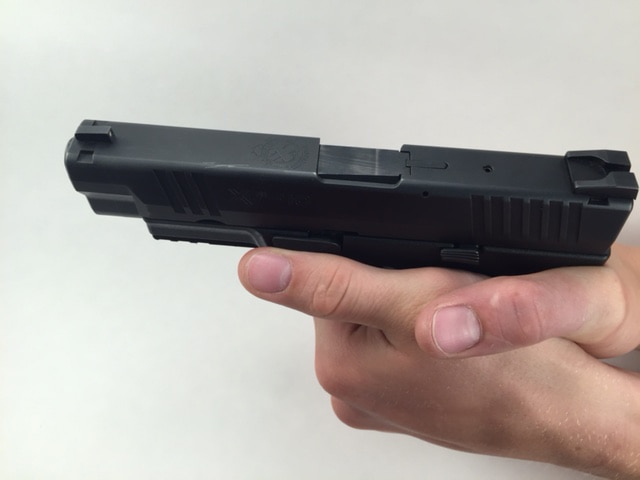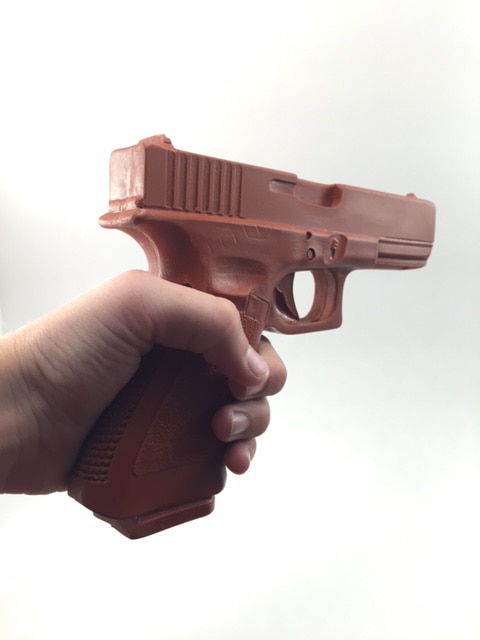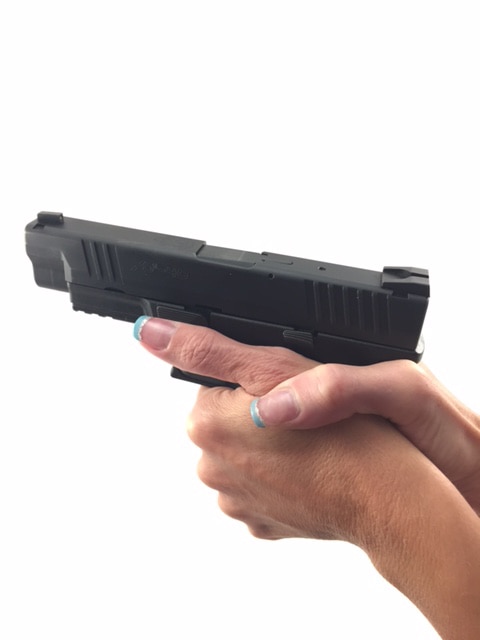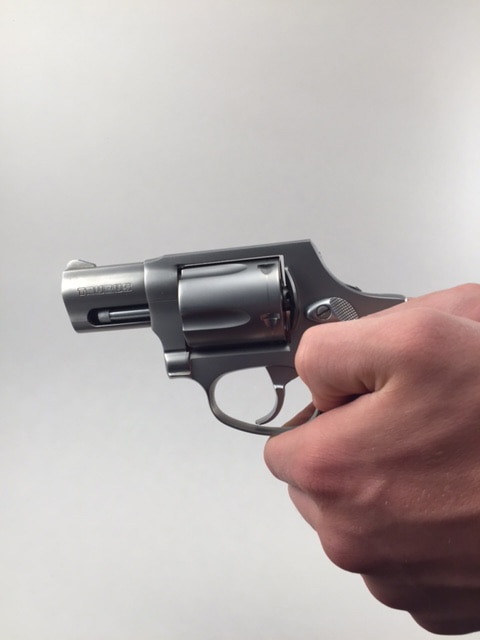
Top-side view of a good, thumbs forward pistol grip with the thumbs away from the slide lock. (Photo: Jeffrey Denning)
There are certainly ways how not to grip a pistol. In the past I’ve outlined at least six ways. But it’s important to review the elements and principles of how to best hold a pistol in order to control the gun better for single and multiple shots.
Any pistol grip that allows excellent recoil management, contains these elements.
1. Hold up high on the pistol grip

This pistol grips needs to choke up. (Photo: Jeffrey Denning)
The “V” notch in our hands—the web-like part in between the thumb and the pointer finger—should be up high on the back of the pistol grip, getting as near to the slide as possible. Keeping the hand up high on the grip will help align the barrel properly so the recoil can be better managed.
Additionally, by holding up high on the grip, the rest of the shooting hand naturally goes to the correct place. Specifically, the middle finger of the three-finger grip will touch the base of the trigger guard, and the index finger will naturally point along the frame of the gun into the correct index position.
2. Put both thumbs on the same side of the gun

Good grip with the thumbs on the same side of the slide and away from the slide lock. (Photo: Jeffrey Denning)
It should be rather obvious that when grabbing a pistol the support hand thumb should go on the same side as the shooting hand thumb. Simple deductive reasoning shows that in order to make the pistol extract, eject and load shell casings and rounds, the slide needs to, well, slide back and forth without obstruction. Sadly, people who are not familiar with pistols or firearms in general tend to grab the gun and grip it any way they can. Sometimes this can get ugly.
Although rare, I actually heard from a solid source about a guy that had to get seven stitches because he wrapped his support hand thumb around the back of a Sig Sauer and pulled the trigger.
3. Face both thumbs forward toward the muzzle

The infamous and incorrect cup-and-saucer grip. (Photo: Jeffrey Denning)
Not only should the thumbs be on the same side of the pistol, but in order to make the most effective and efficient grip possible, the support hand thumb should face forward alongside the frame with the shooting hand thumb also facing forward. This thumbs forward grip is far better than a thumbs down, a thumbs crossed or a cup-and-saucer grip. Having the thumbs forward allows greater stability with the gun, which can help with both accuracy and recoil management.
4. Keep your fingers together and up tight against the base of the trigger guard

Correct thumbs forward grip. (Photo: Jeffrey Denning)
I already mentioned that you should have your three-finger shooting hand grip up tight against the trigger guard. I rarely see this mistake, however, where a lot of pistol shooters can improve is keeping the fingers tight together and tight up against the trigger guard. Keeping the fingers together tightly gives them more strength. To best illustrate this, if you took one no. 2 pencil you could break it pretty easily, but if you put four pencils together it would be more difficult to break. Likewise, with your fingers close together it gives more strength, allowing better recoil management.

A thumbs down grip on a revolver may be advantageous. (Photo: Jeffrey Denning)
Placing a finger in the front portion of the trigger guard does not give as good as control as one might think because it separates the three fingers of the support hand from the other finger, which lessens strength. It also creates an awkward shooting platform that does not transfer well to other guns, since some pistols have a curved trigger guard. If you are only doing static shooting, never shooting under stress, and not shooting as well as you potentially could then this odd-ball technique will do, but if not, you need to keep the fingers of your support hand grip together tight and touching the underneath of the trigger guard.
5. Place your dominant thumb over the top of your support hand

Top view of pistol grip on 1911. Note that the thumb is close to the slide. (Photo: Jeffrey Denning)
Too often pistol shooters have the tendency to over-tighten the grip of their shooting hand. This can lead to an inadvertent malfunction that locks the slide to the rear when the magazine is still loaded. To point, if the thumb of the shooting hand tightens towards to frame—a natural sympathetic movement when the trigger finger tightens and one that can be magnified occur under stress—the thumb can accidentally push the slide lock up, locking the slide back. To combat this, place the shooting hand thumb on top of the support hand thumb and about 45-degrees away from the pistol’s slide. I’d use this for all pistols. The only exception to this would be the 1911, where the safety is alongside the frame and allows a good resting position for the shooting hand thumb.
Until next time, continue to hone your skills and keep adding to your tactical toolbox.
Safety warning: Jeffrey Denning is a long time self-defense professional and any training methods or information he describes in his articles are intended to be put into practice only by serious shooters with proper training. Please read, but do not attempt anything posted here without first seeking out proper training.
The post 5 elements of a killer pistol grip (PHOTOS) appeared first on Guns.com.
